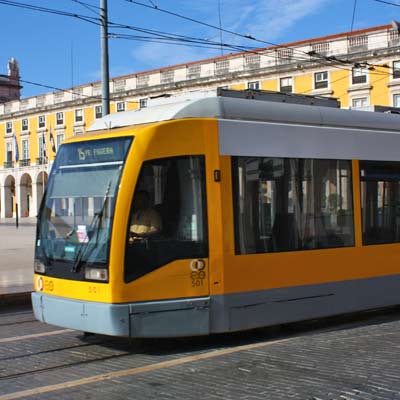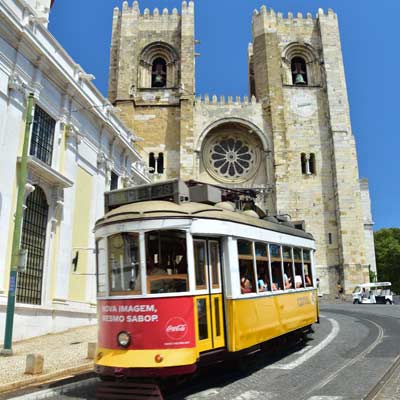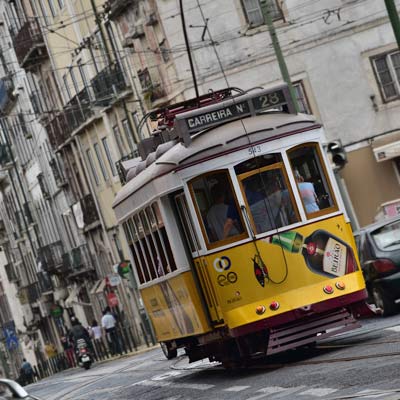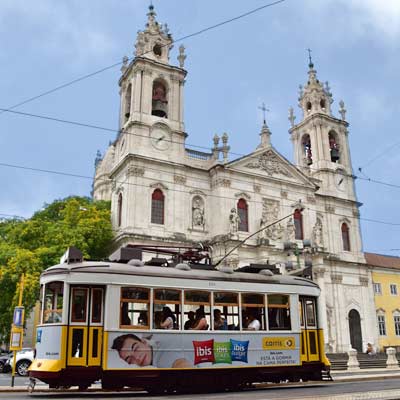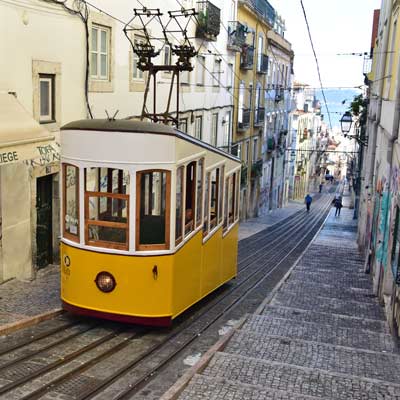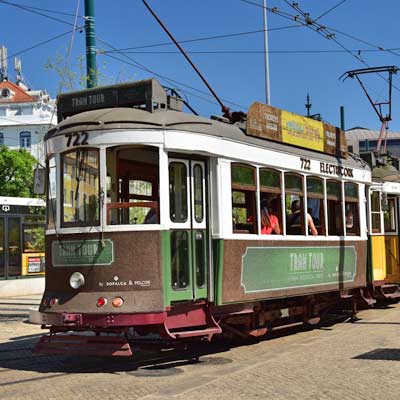LisbonLisboaPortugal.com
The best independent guide to Lisbon
LisbonLisboaPortugal.com
The best independent guide to Lisbon
Lisbon tram guide - updated for 2025
Lisbon's trams are an integral part of the public transport network, and cover many of the areas of the city where there is no access to the metro.
There are two distinct types of trams, the historic "Remodelado" trams or the modern Siemens "Articulado" trams.
The Remodelado trams are the quaint yellow trams that rattle and screech through the narrow streets of Lisbon. The most scenic route is the E28, which passes through much of the historic centre, and is often a highlight of the city.
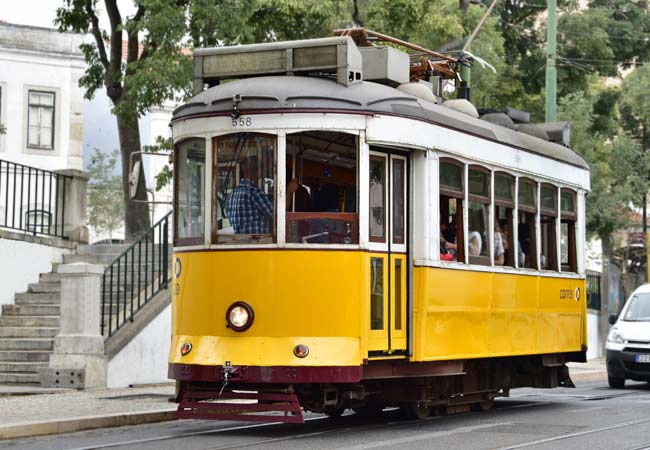
The distinctive yellow Remodelado trams
The Articulado trams provide a higher passenger capacity but are confined to the flat sections of the city, and only operate along the E15, which connects central Lisbon to the Belem district. Belem is a popular tourist district, with many outstanding attractions and historical monuments, and the E15 tram is the best method to travel to Belem.
Along with the main public transport routes, there is a selection of tourist tram tours, but these are significantly more expensive. This article will provide an introduction to Lisbon's tram network, including details of fares, timetables and other useful tourist information.
Related articles: The Belem district – The Alfama district – Top 10 Lisbon
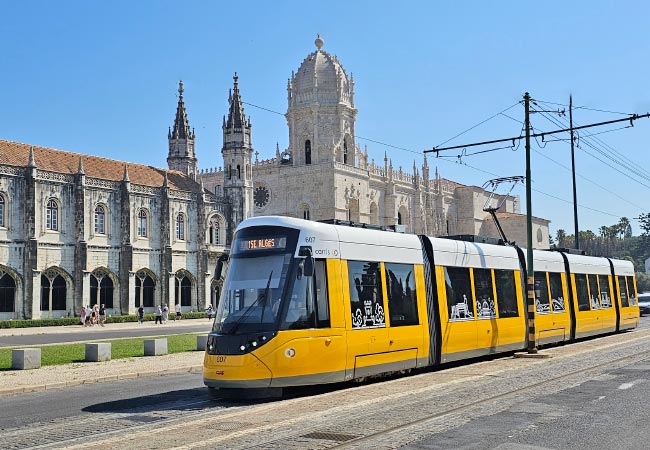
The number 15 tram in Belem
Overview of Lisbon’s trams
The following is a summary of each of the tram routes in Lisbon and why you would want to ride them. At the end of this section is a map which shows the tram routes.
E28 – Martim Moniz to Campo Ourique (Prazeres)
This is the classic tram route through the Alfama, Baixa and Chiado districts, and connects the eastern and western sides of central Lisbon. The route passes through many of the historic areas of Lisbon, and you will want to ride this route during your stay in Lisbon. Unfortunately, the 28 tram gets very busy during the day and is best ridden early in the day.
Related article: E28 tram guide
E15 - Praça Figueira to Algés
The number 15 tram route connects central Lisbon (Baixa district) to the Belem district, and passes the Lxfactory and the Santo Amaro Docks. This is the best way for you to travel from central Lisbon to Belem.
Related article: E15 tram guide.
Warning: Highly skilled pickpockets operate along this route, always be careful with valuables
E12 - Martim Moniz to Martim Moniz (Alfama loop)
The number E12 tram is a one-directional loop (clockwise) through the Baixa, Mouraria and Alfama districts. The E 12 follows the scenic section of the E28 route as is passes through the Alfama district and is a good alternative to the E28.
Related article: E12 guide
E24 - Praça Luis Camões to Campolide
Connects the Chiado district with the Príncipe Real district. This route is useful if you wish to explore Príncipe Real, as you can be dropped off at the northern end (near Rato metro) and then walk southernly through Príncipe Real. This is also the quietest route that uses the Remodelado trams.
Related article: E24 tram
E 18 - Cais do Sodré to Belem
This route follows the 15E route and provides extra capacity for the busiest section, between Cais do Sodré to Belem. This route used to connect Cais do Sodré to the Ajuda Palace, but extended repair work means the route has been permanently altered. To travel to the Ajuda Palace catch the E18 bus.
E25 - Martim Moniz to Campo Ourique (Prazeres)
Connects the Baixa district to Estrela, and passes through the Lapa district and Cais do Sodré. This is the route least used by visitors, but provides an alternative route to Estrela and passes through some of the most affluent neighbourhoods of Lisbon.
Below is an interactive map which displays the tram routes of Lisbon.
Key: Green - E28, Blue - E15, Purple - E12, Yellow - E24, Grey- E25
Insight: The Lisbon tram routes are given a number with a proceeding E which stands for “eléctrico”.
Insider Tip: The E28 is one of the best tours of Lisbon but is standing room only between 10am-6pm. The best way to get a seat is to board the tram at either of the departure locations at Martim Moniz to Campo Ourique.
Lisbon tram fares and tickets
All of Lisbon’s trams and buses are operated by Carris and the fare system covers all tram routes.
A single tram ticket purchased onboard the tram costs €3.10. On the Articulado trams, tickets are purchased from the on-board ticket machines while on the older Remodelado they are bought from the driver.
Purchasing a ticket on the tram is more difficult than it sounds, both types of trams are always very crowded, and on the Articulado tram, the ticket machine needs exact change.
Tram timetables for Lisbon
The tram is an important part of Lisbon’s public transport network and the operational hours reflect the importance of each route. For the 15E and 28E, the services start early in the day (7am) and continue late into the night (11pm) with at least four hourly departures.
The 12E continues until 8pm, while the E18 routes finishes after the evening rush hours and does not run on Sundays. The 25E is the most limited, as it does not even operate at the weekends… The exact timetables can be seen on the Carris website:
www.carris.pt/
Even if you know the exact times, the trams have regular delays due to traffic, staffing issues or badly parked cars. At all of the major tram stops, there are digital information boards which accurately display the departure time of the next tram. These boards are much more useful than the timetables.
Tourist insight: The unspoken rule of Lisbon’s trams (the older Remodelado style) and buses is that you board at the front by the driver and exit to the rear. If you try to exit a bus or tram at the front, expect disapproving stares from older Portuguese
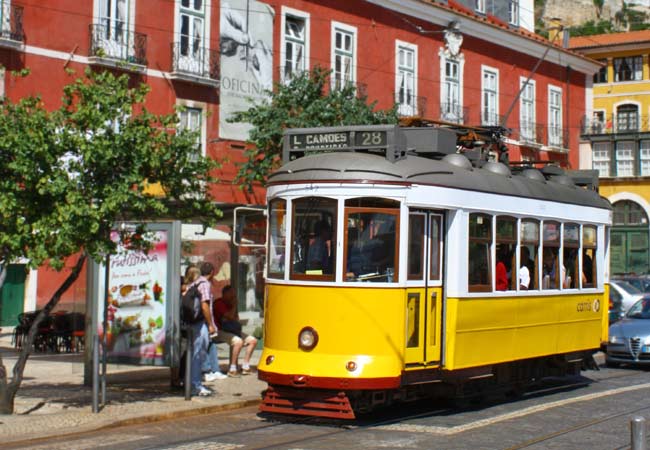
The Lisbon tram number 28, at Portas do Sol in Alfama
Pickpockets on the trams
Why does Lisbon still use the Remodelado trams?
No other city in Europe employs such old trams as the Remodelado trams, which originally date from the 1930s. The reason why they still operate in Lisbon is that the streets are too tight for longer trams, and too undulating for multiple bogie vehicles.
Most normal tram routes have shallow or no inclines, with wide turns and plenty of space, but not in Alfama! The tram tracks in Alfama are the world's steepest, while the turning circle of the single carriage only just miss the edges of the ancient overhanging buildings.
When the entire tram network was upgraded in the 1990s, only the 15E route could be switched to modern trams. As part of the project, it was deemed more appropriate to upgrade the historic trams with new engines, brakes and electronics; hence the trams were re-modelled (Portuguese Remodelado).
Discover more of Lisbon with our most popular guides
If you've found our content valuable, we'd welcome your support.
The digital publishing landscape has evolved significantly. As a small independent publisher, we face growing challenges. Search engines increasingly favour paid content over organic results, while AI-generated content often reproduces original work without attribution.
To support our work, please consider bookmarking this page (press Ctrl + D) for quick access. If you find an article helpful, we'd be grateful if you'd share it with friends on social media.
For specific questions, please see our Reddit community at r/LisbonPortugalTravel.
Should you notice any outdated or incorrect information, please contact us at [email protected]
Thank you for helping us continue to provide valuable content in an increasingly challenging digital environment.
A complete list of all of our Lisbon articles
If you've found our content valuable, we'd welcome your support.
The digital publishing landscape has evolved significantly. As a small independent publisher, we face growing challenges. Search engines increasingly favour paid content over organic results, while AI-generated content often reproduces original work without attribution.
To support our work, please consider bookmarking this page (press Ctrl + D) for quick access. If you find an article helpful, we'd be grateful if you'd share it with friends on social media.
For specific questions, please see our Reddit community at r/LisbonPortugalTravel.
Should you notice any outdated or incorrect information, please contact us at [email protected]
Thank you for helping us continue to provide valuable content in an increasingly challenging digital environment.
